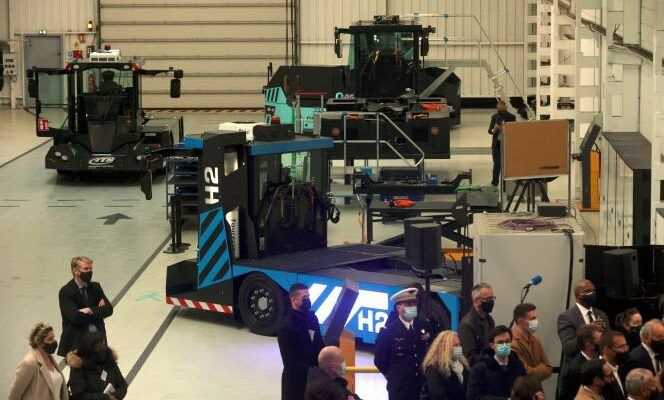The huge hydrogen-powered tractor moves slowly through the vast hangar, then suddenly accelerates, before stopping, sending a shiver through the crowd of officials. At the wheel, happy with its effect, the Minister Delegate in charge of transport, Jean-Baptiste Djebbari, completed, on March 12, an express visit to Bourgogne-Franche-Comté, ending with Héricourt (Haute-Saône), seat of the Gaussin company, specialist in port and airport equipment. An hour earlier, Mr. Djebbari was in Belfort, already driving a hydrogen vehicle – a postman’s cart – rushing through the winding alleys of the prefecture. The minister was preparing, in the presence of an assembly of elected officials, to give a check for 800,000 euros to the Mauboussin company, designer of small airplanes… with hydrogen.
Like a mantra, the word is out: hydrogen. In government communication, as in that of companies, this gas (H2, according to the chemical abbreviation) is presented as a solution adorned with all the virtues for the mobility of tomorrow. While many promising projects are underway, the road is still long and the results uncertain. Combined with a fuel cell, hydrogen makes it possible to produce electricity and rejects water. In a car or truck, it is much more practical than a battery: the vehicle is electric, but the user fills it up in a few minutes like at a gasoline pump. And then the resource is inexhaustible. Hydrogen can be extracted everywhere, by electrolysis, by passing current produced by a wind turbine and solar panels through water.
Above all, hydrogen has become the new economic sesame for entrepreneurs, elected officials and French politicians of all levels, from all sides and from all corners of France. It is even to an extraordinary flowering of mobility projects H2 that we have been witnessing for several months in France, stimulated by the impetus of the State and its Hydrogen plan of 7.2 billion euros over ten years, presented in September 2020.
Abundance of projects
For mobility alone, the Ministry of Transport lists 28 major hydrogen ecosystem projects supported by the State launched for less than two years across the country. There a fleet of buses, here dumpsters, taxis or scooters, elsewhere river shuttles, or the famous Alstom hydrogen trains bought by four regions. And that’s without counting the dozens of more modest initiatives (stations, captive fleets, educational demonstrators) which are popping up everywhere. The Vig’Hy hydrogen observatory identifies more than 150 in France.
You have 73.12% of this article to read. The rest is for subscribers only.
